Photobiomodulation has beneficial effects on chronic pain and inflammation
ABSTRACT: The main objective of this literature review was to analyze the efficacy of (PBM) therapy application on subjects with chronic pain and inflammation, and furthermore, to evaluate the methodological quality of the collected literature. The search was conducted using five databases: PubMed, ProQuest, Scopus, Web of Science, and PEDro. The keywords “low level laser therapy”, “chronic pain”, and “inflammation” provided the selection of RCTs that were published within the last 5 years, conducted in humans, and written in English. The PEDro Internal Validity Scale (IVS) checklist was used to evaluate the risk of bias in the included studies. A total of 11 articles were selected, all of them RCTs. Of the articles, five showed that PBM positively influences chronic pain, while another showed the same but only in the short term. In two other articles, the patient’s inflammation improved markedly. In one article there was no improvement in chronic pain and in another, there was no improvement in inflammation. Four articles demonstrated that PBM is beneficial in acute pain. Furthermore, six studies were given an “excellent” score and the remaining five a “good” score based on the IVS. Photobiomodulation has beneficial effects on chronic pain and inflammation, although more research needs to be completed in this line for this to be clarified as the existence of RCTs on this subject is limited.
The clinical trial results suggest that whole-body PBM can significantly reduce pain and improve the quality of life in patients suffering from FM
ABSTRACT: Fibromyalgia (FM) is a chronic musculoskeletal pain condition that affects millions of people worldwide. Characterized by sensory hypersensitivity, it often results in reduced quality of life, limited physical activity, and psychological symptoms. Photobiomodulation (PBM) is a therapeutic intervention that uses light to stimulate the body’s natural healing processes and has shown positive effects in relieving pain. However, there have been no studies on whole-body PBM intervention in subjects with FM.
Photobiomodulation works by using light energy to stimulate cellular function, resulting in the release of endorphins and other pain-relieving molecules. The treatment is non-invasive and can be administered in a doctor’s office or at home using a device. The light energy is delivered via a device that emits specific wavelengths of light, which penetrate the skin and interact with cells in the body. The treatment is painless and has no known side effects, making it a safe alternative to traditional pain management methods.
Use of PBM may be an efficient method for the management of orofacial pain in patients with acute and chronic TMJ disk displacements and may reduce the recovery time
ABSTRACT: Pain related to temporomandibular disorders (TMD) is a common problem that can significantly influence a patient’s quality of life. Laser photobiomodulation (PBM) has been reported as a promising method in medicine for wound and bone healing, pain relief, and treatment of the temporomandibular joint (TMJ). Our clinical case aimed to demonstrate the effectivity of PBM using 1064 nm Nd:YAG laser for the treatment of pain and restricted mandible movement in a patient with anterior disk displacement of the left TMJ, using subjective (pain on visual analogue scale – VAS) and objective outcome measures [dynamic magnetic resonance imaging (MRI)]. PBM was performed on the left condyle in four sessions using a 1064 nm Nd:YAG laser with a flat-top handpiece. Results after 10 weeks showed an increase in mouth opening and a painless joint on palpation, with no reported adverse effects. An MRI of the TMJ confirmed the left disk displacement, however, with no signs of inflammation or effusion and with less pronounced disk deformity as compared with the first MRI examination. Use of PBM with Nd:YAG laser may be an efficient method for the management of orofacial pain in patients with acute and chronic TMJ disk displacements and may reduce the recovery time.
Photobiomodulation has beneficial effects on chronic pain and inflammation
ABSTRACT:
Effective treatment for fibromyalgia (FM) is lacking and further treatment options are needed. Photobiomodulation therapy (PBMT) represents one potential treatment option. Whilst favourable findings have been reported using localised PBMT, no investigations have established the value of whole-body PBMT for the complete set of symptom domains in FM. A single-arm feasibility study was conducted in accordance to CONSORT guidelines. A non- probability sampling method was used to access individuals with FM. The primary outcome measure was identified as the Revised Fibromyalgia Impact Questionnaire (FIQR). Forty-nine participants were screened and 21 trial participants entered the trial. Nineteen participants completed the intervention (18 whole-body PBMT sessions over approximately six weeks). Descriptive statistics and qualitative analysis was undertaken to represent feasibility outcomes. Acceptability of the trial device and processes were established. Outcome measures towards efficacy data were guided by core and peripheral OMERACT domains, utilising a combination of participant-reported and performance-based outcome measures. Positive changes were observed for FM-specific quality of life, pain, tenderness, stiffness, fatigue, sleep disturbance, anxiety, depression and cognitive impairment. Patient global assessment revealed improvements at 6 weeks, with continued effect at 24 weeks. FM- specific quality of life at 24 weeks remained improved compared with baseline scores. Data for the embedded qualitative component of the trial were captured by participant-reported experience measures and audio-recorded semi-structured interviews. Findings provide evidence to support a full-scale trial and shows promise regarding potential efficacy of this novel non-invasive treatment in an FM population.
Photobiomodulation as an Adjunctive Treatment to Physiotherapy for Reduction of Anterior Knee Pain in Combat Soldiers: A Prospective, Double-Blind, Randomized, Pragmatic, Sham-Controlled Trial
Anterior knee pain (AKP) is the most common knee pathology in athletes and occurs in 15% of army recruits of elite units during basic training. Of these, 50% are symptomatic 6 years later. Photobiomodulation (PBM) is a nonthermal red-to-near-infrared irradiation used for pain reduction of a variety of etiologies. This study was designed to determine whether addition of PBM to physiotherapy (PT) for AKP in combat soldiers is superior to PT alone.
Read more on National Institutes of Health»
A growing body of evidence supports the modulation of pain by light exposure
ABSTRACT: A growing body of evidence supports the modulation of pain by light exposure. As such, phototherapy is being increasingly utilized for the management of a variety of pain conditions. The modes of delivery, and hence applications of phototherapy, vary by wavelength, intensity, and route of exposure. As such, differing mechanisms of action exist depending upon those parameters. Cutaneous application of red light (660 nm) has been shown to reduce pain in neuropathies and complex regional pain syndrome-I, whereas visual application of the same wavelength of red light has been reported to exacerbate migraine headache in patients and lead to the development of functional pain in animal models. Interestingly visual exposure to green light can result in reduction in pain in variety of pain conditions such as migraine and fibromyalgia. Cutaneous application typically requires exposure on the order of minutes, whereas visual application requires exposure on the order of hours. Both routes of exposure elicit changes centrally in the brainstem and spinal cord, and peripherally in the dorsal root ganglia and nociceptors. The mechanisms of photobiomodulation of pain presented in this review provide a foundation in furtherance of exploration of the utility of phototherapy as a tool in the management of pain.
PBM Now Recommended for Treating Pain

JAMA lists low-level laser therapy as a recommended option for treating low back pain lasting more than 12 weeks.
—JAMA Patient Page
American College of Physicians Guidelines include a “strong recommendation” for Low-Level Laser Therapy as a non-invasive Treatments for Acute, Subacute & Chronic Low Back Pain
Noninvasive Treatments for Acute, Subacute, and Chronic Low Back Pain: A Clinical Practice Guideline From the American College of Physicians.
Qaseem A, Wilt TJ, McLean RM, Forciea MA, Clinical Guidelines Committee of the American College of Physicians
From the American College of Physicians and Penn Health System, Philadelphia, Pennsylvania; Minneapolis Veterans Affairs Medical Center, Minneapolis, Minnesota; and Yale School of Medicine, New Haven, Connecticut.
DESCRIPTION: The American College of Physicians (ACP) developed this guideline to present the evidence and provide clinical recommendations on noninvasive treatment of low back pain. Methods: Using the ACP grading system, the committee based these recommendations on a systematic review of randomized, controlled trials and systematic reviews published through April 2015 on noninvasive pharmacologic and nonpharmacologic treatments for low back pain. Updated searches were performed through November 2016. Clinical outcomes evaluated included reduction or elimination of low back pain, improvement in back-specific and overall function, improvement in health-related quality of life, reduction in work disability and return to work, global improvement, number of back pain episodes or time between episodes, patient satisfaction, and adverse effects.
Thor
Low-level laser therapy for chronic non-specific low back pain: a meta-analysis of randomised controlled trials
The British Medical Journal (BMJ) conducted a meta-analysis of randomized controlled trials examining the efficacy of PBM for chronic non-specific low back pain which found “moderate quality of evidence” and “clinically important benefits” in the short term.
BMJ Publishing Group Limited

